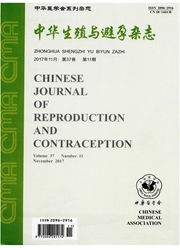

 中文摘要:
中文摘要:
目的研究不同低碘含量饲料对Wistar子代雄鼠血清及睾丸抗氧化能力的影响。方法对SPF级Wistar雌鼠长期喂饲碘含量分别为20 mg/kg(A组)、50 mg/kg(B组)、300 mg/kg(C组)饲料,检测"三代两窝"传代后子二代喂养3个月、6个月、9个月时雄鼠血清、睾丸组织超氧化物歧化酶(SOD)、谷胱甘肽过氧化物酶(GSH-Px)活性及丙二醛(MDA)的含量。结果从亲代开始长期进食低碘饲料明显影响子二代雄鼠血清及睾丸抗氧化能力,且饲料碘含量越低影响越明显。血清SOD、睾丸组织GSH-Px受低碘影响最显著(P〈0.05)。进一步分析造成睾丸抗氧化能力降低的因素,结果表明与低碘影响睾丸组织细胞线粒体SOD活性有关(P〈0.05)。结论随低碘影响周期越长,机体碘营养水平越差,对子代抗氧化能力影响越明显,说明碘缺乏干预应在早期进行,也提示适时进行碘缺乏高危对象抗氧化能力检测可作为判断碘缺乏损伤的指标之一。
 英文摘要:
英文摘要:
Objective To explore the effect of different low iodine content of feed on serum and testis antioxidant capacity of the next generation Wistar male rats.Methods SPF-level Wistar female rats were randomly separated into three different groups, and fed with different iodine content food, 20 mg/kg (group A),50 mg/kg (group B) and 300 mg/kg (group C) for a long period. Based on the搕hree generations of two nest animal model establishment method, the second-generation rat iodine deficiency animal model was established. After 3, 6, 9 months of feeding low iodine food, superoxide dismutase (SOD), glutathione peroxidase (GSH-Px) activity and malonic dialdehyde (MDA) content of serum and testis tissues were determined. Results The serum and testicular antioxidant capacity of young second-generation rats were influenced by long-term low iodine diet that started from parental generation. The lower the level of iodine content, the more obvious the impact was. When comparing the serum SOD and testis tissue GSH-Px, there was a significant difference between low iodine groups and normal control groups (P〈0.05). There was a close connection between the decreasing antioxidant capacity of testis and mitochondrial SOD activity affected by low iodine after further analysis.Conclusions According to the results, the effect of antioxidant ability in next generation iodine deficiency rats becomes more obvious with the longer low-iodine feeding as well as the decreasing iodine level. It indicates that iodine deficiency disorders prevention must be started at early age. Also, the detection of antioxidant capacity of iodine deficiency among high-risk population could be used as one of the indicators of iodine deficiency injury.
 同期刊论文项目
同期刊论文项目
 同项目期刊论文
同项目期刊论文
 期刊信息
期刊信息
